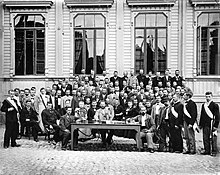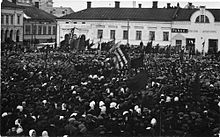Socialism in Finland

Socialism in Finland is thought to stretch back to the latter half of the 19th century in the Grand Duchy of Finland, with the increasing industrialization of Finland.
History
[edit]| Part of a series on |
| Socialism |
|---|
 |
Wrightian era
[edit]The beginnings of the labour movements began in the late 1800s with the establishment of labour unions. The Helsinki Worker's Association and Tampere Worker's Association were established in the 1880s and did not originally believe in socialist values. Instead many labour associations and unions were founded by members of the Bourgeoisie. These Labour unions supported the Wrightian labor movement, a socially liberal social movement that sought to advance liberal interests and cooperation, such as cooperation with the temperance and feminist movement.[1]
This time period for the working class movement was dubbed the Wrightian era. Much of the labour movement during the time period had extremely strong connections to political parties such Young Finns, as the Labour Association was led by them from 1897-1898.[1] Yrjö Mäkelin would become the chairman of the labour movement in the 1890s,[2] and would found Kansan Lehti, a socialist newspaper in December 1898.[3] Radicalization of the labour movement would come in the 1896, when information about the demands of the labour movements in other countries in Europe had reached Finland.[1] This led to the Second Workers' Association Assembly being held in Tampere, in which more socialist ideas were adopted to the belief of the labour unions.[4] This marked the end of the Wrightian era, due to the dissatisfaction with the liberal cause,[1] especially among labourers. The arrival of socialist ideas from overseas led to the labour movement and unions perusing the socialist cause, these labour unions would found the Finnish Labour Party in Turku in 1899.[5]
The Finnish Labour Party was founded based off the principles of the mainstream labour movement. The Labour Party adopted the following program as immediate and necessary goals of the movement, with later goals to be debated upon:[6]
- General, equal, and direct voting rights for all Finnish citizens aged 21 and over, regardless of gender, in all elections and votes. Proportional representation system. Two-year legislative terms. Elections and votes to be held on a legally designated rest day.
- Legislation and the right of self-taxation for the people through the Parliament.
- Complete freedom of association, assembly, expression, and press.
- Working hours to be reduced to 8 hours. The maximum working hours and minimum hourly wage for state and municipal work to be implemented immediately.
- General compulsory education. Free education in all institutions. Primary school to be organized as the foundational school for all higher institutions.
- The military burden to be greatly reduced, and the idea of peace to be developed and practically implemented.
- Complete equality between men and women.
- A general prohibition law on the production and sale of alcoholic beverages to be enacted.
- Labor protection legislation to be developed. The number of labor inspectors to be significantly increased, and assistants from the working class to be appointed for them. Female inspectors to be appointed as well.
- Gradually increasing income and inheritance taxes. Elimination of all indirect taxes.
- Workers' insurance to be taken under state care.
- Free legal proceedings and free medical assistance.
- The position of movable population tenants and smallholders to be improved.

General Strike of '05
[edit]Background
[edit]
The labour movement in Finland began to gain new found popularity in Finland due to the attempted Russification of Finland (1899–1905), defeat in the Russo-Japanese War and growing class consciousness amongst Finns.[7] The Social Democrats grew fast in popularity and were unordinary compared to the Russian Socialists, who were forced to operate underground.[8] All camps of the political spectrum grew to disdain the Russian Governorship, especially the nationalists, leading to the assassination of Nikolai Bobrikov by Eugen Schauman.[7]
In August, a large amount of Finnish Workers and High school students had demanded universal voting rights, this led to worries in the Aristocracy and the Bourgeoisie, who began demanding the resignation of the Government, led by the Old Finnish Party.
General Strike
[edit]On 30 October, a general strike was proclaimed in Helsinki's Senate Square and in Tampere's Keskustori by workers, who were later joined by students.[9] The strike began first with the railway workers and spread further on from there. The strike paralyzed the nation, in which most schools, factories, shops and offices were closed, and the strike shortly later spread to Viipuri, Turku and Oulu.
The goal of the socialist movement had originally been moderate, a simple protest against against the Russian Governorship. However the general strike had moved the Social Democrats towards the left with the influx of new people sympathetic to the cause, in which the moderates and unionists became the minority.[8] Workers' strike committees were established in Tampere, and across many cities "street parliaments" became a common occurrence. All of this was much too radical for many Young Finns and Svecomen.[10] The demands of the Social Democrats had changed, and their new demands such as a unicameral parliament and equal voting rights for all citizens, were too radical for some. Especially to the Young Finns and to the Finland-Swedes, characterized as the most conservative of the radicals, they began to detach themselves from the movement.[10]
National Guards were created in 1905 as a united front of workers and students against the Russian Governorship.[11] However due to the increasing radicalization of the labour movement, the National Guards split, leading to their eventual separation and the creation of the respective Red Guards and White Guards in Finland.[12] The Red and White Guards were dissolved following the end of the general strike, and would not come back officially until the Finnish Civil War.

On 1 November, the Red Declaration was issued in Keskustori, Tampere, the declaration demanded for equal voting rights for all citizens, and the disestablishment of the Senate, to be replaced by a National Parliament. These demands were then later sent to Helsinki on 4 November, at which point they were accepted. On November 4 in Rautatientori, Helsinki, a provisional government was elected as required by the Red Declaration.

Following the Independence of Finland
[edit]The Civil War and Red Finland
[edit]
Following the beginning of a Civil War in Russia, the People's Delegation was established in Finland by the Finnish Red Guard and other revolutionary socialist organizations, including the most radical-wing of the Social Democratic Party. The new Red Government, took over the Government Palace in Helsinki and began their changes their ideas of a Marxist Finland there. The People's Delegation strongly opposed to the 'Red Terror' that was being done by their Red Guardsmen. The Red Government, proposed changes to the Constitution which were quite liberal and democratic, and not that authoritarian. This included the following:[13]
- 'May such a law never be enacted in Finland, and may no administrator of a public function act in such a way that the right to the mother tongue of a minority speaking another language would be oppressed. Educational institutions working for the education of the minority in their own language should be assisted with public funds according to justice and fairness.'
- 'Let no one be sentenced for a crime to the death penalty or to any punishment causing injury to the body or damage to health.'
- 'All state power belongs to the people, whose representative the supreme power is exercised by the Parliament of Finland, based on the Constitution and according to the decisions of the people.'
- 'In Finland, employees have the freedom to strike and the right to keep an eye on visitors to the workplace during a work stoppage and to urge them to leave work; likewise, they have the right orally and in writing to call on the people to shun the movement subject to a work stoppage, as well as its household and assistants or its goods.'
- 'With a referendum, any decree of the People's Parliament, decision of the People's Delegation or other administrative authority, or court judgment can be revoked and revoked.
The Reds during the Finnish civil war quite liberal with their military policy, letting both women and men serve together, in both combatant and maintenance troops.[14] However the Red Government was also authoritarian in their banning of foreign and domestic anti-revolutionary news, which struck a cord with many people, leading to the banning of socialist newspapers in White Finland.
Communist Party of Finland
[edit]
Following the Civil War, many of the radical-wing of the Social Democratic Party, fled to Soviet Russia, especially to Soviet Karelia. In 1918, in the city of Moscow, the Communists organized the Communist Party of Finland (SKP). The SKP was banned in Finland for having tried to topple the legitimate government and therefore was made illegal to be a part of. Despite this, the SKP still operated underground in Finland, organizing events at workplaces and at public places. In these meetings illegal revolutionary material would be read. The Communist movement was under strict watch by the Finnish Secret Police and Intelligence Agency, and Communist meetings would often be broken up and Communists would be sent to prison for treason at Tammisaari or Hämeenlinna.[15]
The Communist Party would often send in agents into Finland, trying to influence the public to either bring back the Red Guard or to influence and use other almost communistic parties as their puppets in elections. However this did not work, as the Etsivä keskuspoliisi (Secret police) would often capture their informants and agents.[16]
Wartime and Socialism
[edit]Many socialists and conservatives worked together during the Winter War against the Soviet Union, because they saw the importance in Finnish independence, this led to the rise and creation of organizations such as the Union of Finnish Brothers-In-Arms, these organizations were also made as a counter-balance against the Finland–Soviet Union Peace and Friendship Society, which was a Soviet-backed anti-war propaganda organization.
Following the Winter War, sympathizers to the Soviet Union and her actions were removed from the Social Democratic Party. These sympathizers became known as the "six" by people, and they set up their own faction within parliament known as the 'Socialist parliamentary group'.[17] The Continuation War, was a controversial topic within many mainstream parties, and it was opposed by many socialists, who viewed it as a war of aggression and saw it as unjustifiable for the Finns to be allied with Nazi Germany. This sentiment only grew as the war took more and more of a toll on Finnish living standards and as the war turned to a stalemate in East Karelia and it led to the formation of the Peace opposition group.
Cold War
[edit]The Social Democratic Party during the 1950s and 1960s was at fray with the Soviet Union and its Eastern Bloc, due to its party election of 1957 choosing Väinö Tanner to its leadership, who was a convicted war criminal.[18] This alongside other 'mishaps' by the Social Democrats led to the Night Frost Crisis, which led to crisis within the Social Democrats due to the Soviets not accepting the government. The Social Democrats began questionable foreign policy in hopes of warming relations with the Russians.[19] The Social Democrats were not only affected by foreign crises' but by party crises', following a party congress in 1955 which led to a majority being reached for the support of Emil Skog, however Leskinen saw the majority support in the Party council, which held higher authority than the congress. The followers of Skog, who were more conservative social democrat, broke off from the party and formed the Social Democratic Union of Workers and Smallholders.[18]
Finnish People's Democratic League
[edit]The Finnish People's Democratic League was founded as a union of socialists, communists and others, following the Continuation War,[20] when Communism had been legalized forcefully by the Soviets.[21] The Communists held the most influence and sway within the party, due them making up the majority of the party following the most influential socialists within the party either dying or leaving it.[22] However the variety in Communism was clear, and this was a major reason for the party not outright merging with the SKP. The clear Marxist–Leninist ideology of the SKP, was a reason for not unifying the parties outright, as there were fears of Finland turning to authoritarian communism under SKP influence.
The SKDL (Finnish People's Democratic League) was often one of the major players in Finnish elections, through the 1950s to the 1980s, they were consistently in either 2nd, 3rd or 4th place.
Taistoism
[edit]Taistoism was a pro-Soviet faction within the SKP, which was highly influential and opposing to the Eurocommunist tendencies of the party's main line. The ideology was named after its core founder Taisto Sinisalo.[23] The taistoist minority was active in social circles, such as music and youth work. Leading to 'Nuortaistolaisuus' and 'Kulttuuritaistolaisuus', which mean 'Youth Taistoism' and 'Cultural Taistoism' respectively. This shaped the Political song movement of the 1970s heavily, as bands such as Agit-prop, and its record company Love Records spread communist/taistoist messaging.[24]
21st century
[edit]The Social Democratic Party and the new Millennia
[edit]
The Social Democrats in the 21st century advocate for deficit-spending to fund popular social programs, such as universal health care, among other policy ideas.[25] The party is in favor of NATO membership, LGBT rights, such as same-sex adoption rights and for the establishment of an 'environmental administration'.[26]
The Party has held office three times from 1999–, which includes the Lipponen II Cabinet, Rinne Cabinet and the Marin Cabinet.
References
[edit]- ^ a b c d "KOSKESTA VOIMAA – VALTA – 1900–1918 – TAMPEREEN TYÖVÄENYHDISTYS". webpages.tuni.fi. Retrieved 23 November 2023.
- ^ "KOSKESTA VOIMAA - LIIKKUMINEN - AIKAKAUSI 1900-1918 - TAMPEREEN VALTALEHDET". webpages.tuni.fi. Retrieved 10 August 2024.
- ^ Laakoli, Pia (2006). The presentation of Russians in Aamulehti and Kansan Lehti: pro- and anti- Russian propaganda in the fight for public opinion. Tampere.
{{cite book}}: CS1 maint: location missing publisher (link) - ^ "KOSKESTA VOIMAA - VALTA - 1900-1918 - TAMPEREEN TYÖVÄENYHDISTYS". webpages.tuni.fi. Retrieved 10 August 2024.
- ^ "Puoluehistoriaa – Vaalit.fi". Archived from the original on 30 January 2018. Retrieved 23 November 2023.
- ^ "SDP Suomen Sosialidemokraattinen Puolue www.sdp.fi". 28 February 2006. Archived from the original on 28 February 2006. Retrieved 23 November 2023.
- ^ a b "Suurlakko 1905 | Suojeluskunnat ja Lotta Svärd" (in Finnish). 17 July 2014. Retrieved 10 August 2024.
- ^ a b "Finland's Revolution". jacobin.com. Retrieved 10 August 2024.
- ^ "KOSKESTA VOIMAA – VALTA – AIKAKAUSI 1900–1918 – Suurlakko". webpages.tuni.fi. Retrieved 23 November 2023.
- ^ a b Reitala, Aimo; Apunen, Osmo (1987). Suomen historia: Romantiikasta modernismiin (in Finnish). Weilin + Göös. ISBN 978-951-35-2495-1.
- ^ "DSpace". helda.helsinki.fi. Retrieved 23 November 2023.
- ^ Haapala, Pertti; Löytty, Olli; Melkas, Kukku; Tikka, Marko (2008). Kansa kaikkivaltias: Suurlakko Suomessa 1905. Helsinki: Kustannusosakeyhtiö Teos. ISBN 978-951-851-167-3.
- ^ "Kansanvaltuuskunnan ehdotus Suomen valtiosäännöksi 23.2.1918". www.histdoc.net. Retrieved 23 November 2023.
- ^ The Finnish Civil War 1918: History, Memory, Legacy. BRILL. 14 August 2014. ISBN 978-90-04-28071-7.
- ^ Krekola, Joni (2006). Stalinismin lyhyt kurssi: Suomalaiset Moskovan Lenin-koulussa 1926–1938. Bibliotheca historica. Helsinki: Suomalaisen Kirjallisuuden Seura. ISBN 978-951-746-864-0.
- ^ Saarela, Tauno (1996). Suomalaisen kommunismin synty 1918–1923. Helsinki: Kansan Sivistystyön Liitto. ISBN 978-951-9455-55-6.
- ^ Mickelsson, Rauli (2007). Suomen puolueet: historia, muutos ja nykypäivä (in Finnish). Vastapaino. ISBN 978-951-768-217-6.
- ^ a b Lyytinen, Eino (1995). Mauno Koivisto: tie politiikan huipulle. Porvoo: Söderström. ISBN 978-951-0-19811-7.
- ^ Karjalainen, Ahti; Tarkka, Jukka (1989). Presidentin ministeri: Ahti Karjalaisen ura Urho Kekkosen Suomessa (3. painos ed.). Helsingissä: Otava. ISBN 978-951-1-08892-9.
- ^ Haikara, Kalevi (1975). Isänmaan vasen laita: SKDL 30 vuotta piikkinä kansakunnan lihassa (in Finnish). Otava. ISBN 978-951-1-02144-5.
- ^ "Välirauha-sopimus". heninen.net. Retrieved 26 November 2023.
- ^ Viitala, Heikki Mikko (1988). Vasemmistolainen työväenliike Suomessa (in Finnish). Suomen Kommunistinen Puolue. ISBN 978-951-99933-5-5.
- ^ Starck, Kathleen (19 February 2010). Between Fear and Freedom: Cultural Representations of the Cold War. Cambridge Scholars Publishing. ISBN 978-1-4438-2029-5.
- ^ Saarikangas, Kirsi, ed. (2004). Koti, kylä, kaupunki: (1900–2000). Suomen kulttuurihistoria / [sarjan toimituskunta: Laura Kolbe, päätoimittaja .̤]. Helsinki: Tammi. ISBN 978-951-31-1845-7.
- ^ "Talouspoliittiset linjaukset – SDP – Talouspolitiikka". SDP (in Finnish). Retrieved 8 December 2023.
- ^ "Ohjelmatyö". SDP (in Finnish). Retrieved 8 December 2023.
